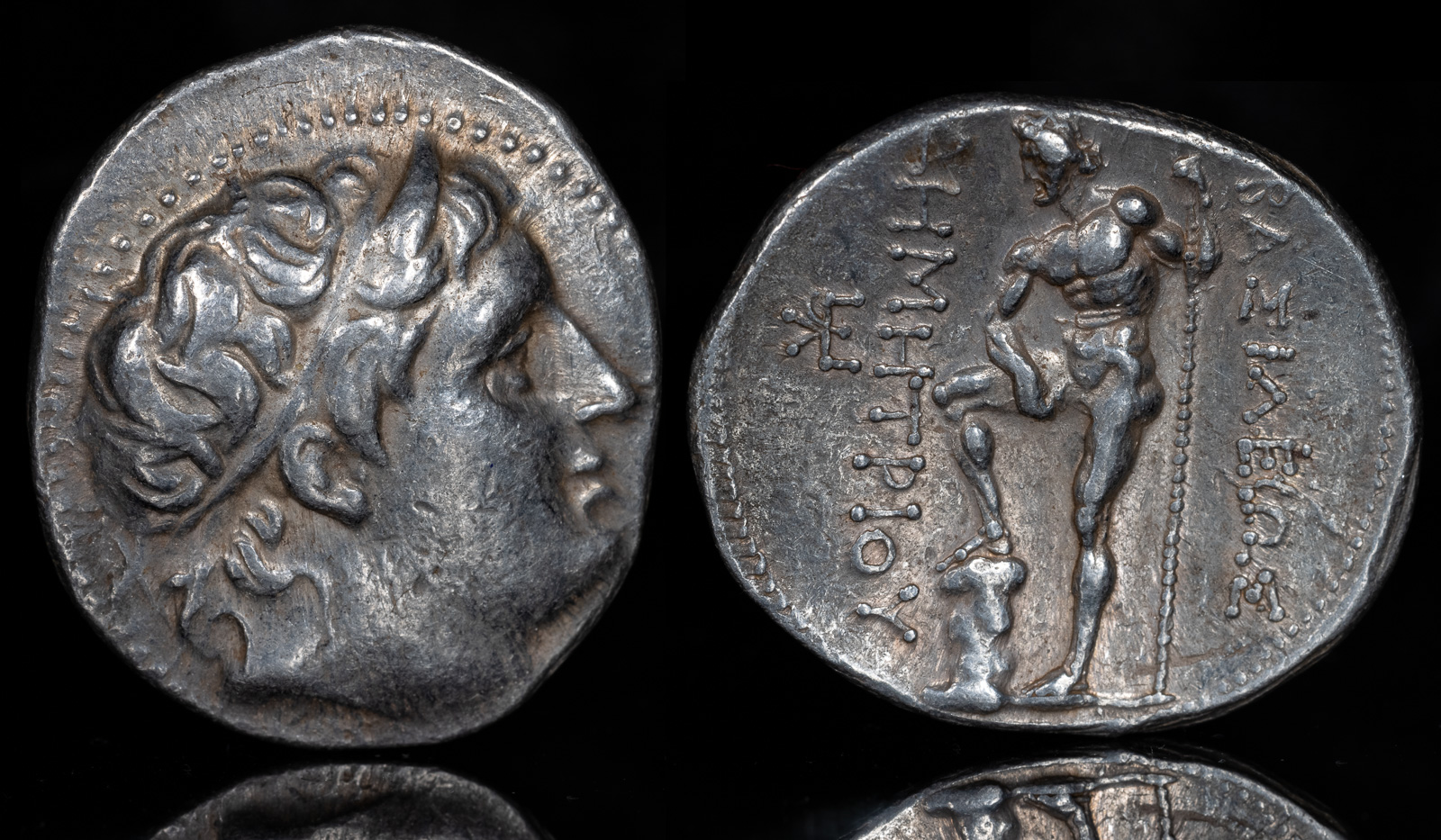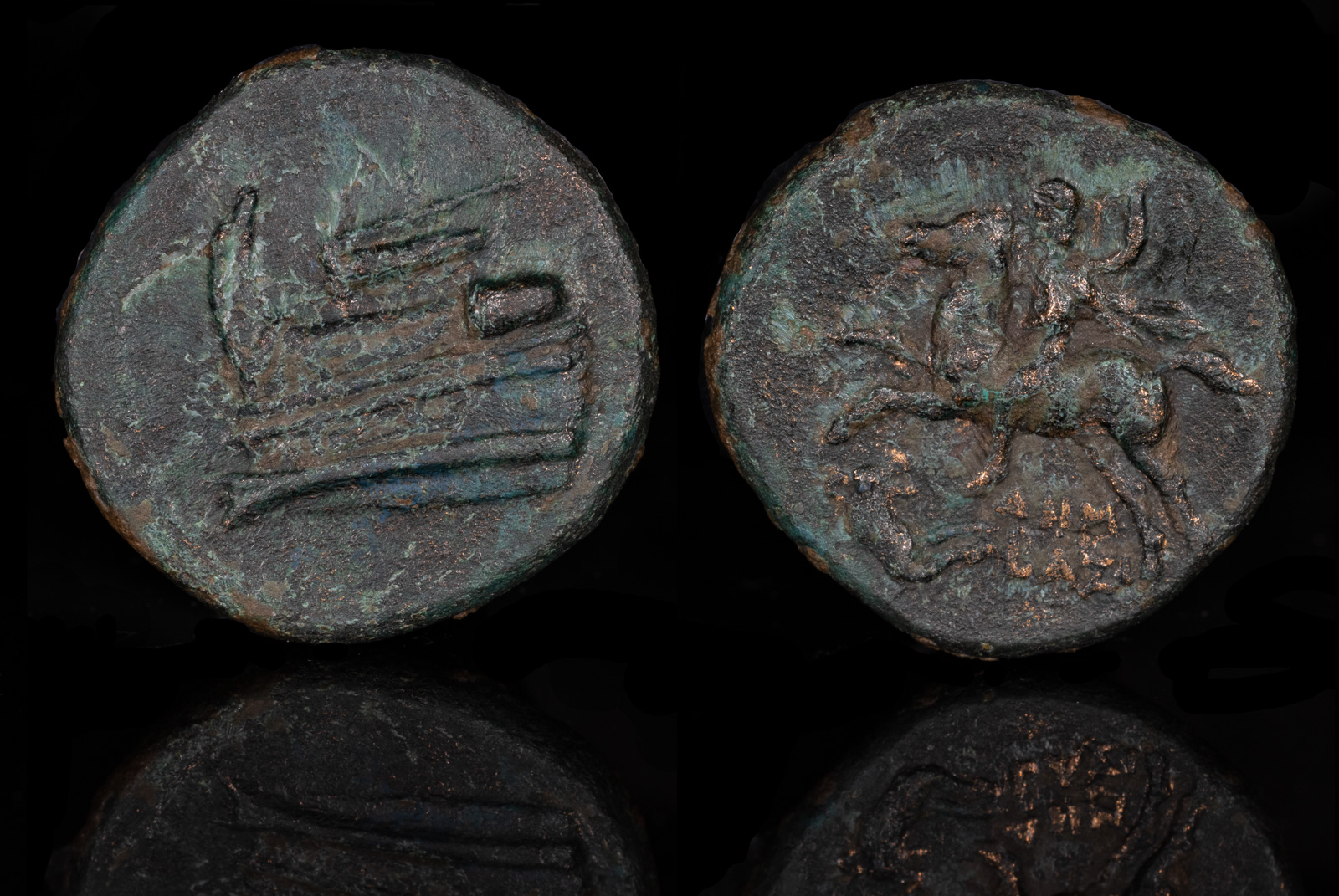
Kings of Macedon. Pella. Demetrios I Poliorketes 306-283 BC.
Tetradrachm AR 30 mm, 17,12 g
Diademed and horned head of young Demetrios right / ΒΑΣΙΛΕΩΣ ΔΗΜΗΤΡΙΟΥ, poseidon standing left resting foot on rock, monograms at either side.
Newell 90
Demetrios I Poliorketes was easily among the most intriguing of the Diadochi. After the other Hellenistic kings took the dramatic step of placing the bust of Alexander the Great on their coins, marking the first actual person (albeit deceased) instead of a deity on a coin, Demetrios took it a step further and put his own image on his coins.
On the other side is Poseidon, who Demetrios used to remind everyone about his naval mastery of Ptolemy in the Battle of Salamis. While most of the Diadochi were very effective advertisers on their coins, Demetrios seems to have been the best.
His name Poliorketes means “besieger of cities” and Demetrios earned this nickname by devising massive siege engines for the multiple cities he surrounded. Places like Rhodes and Athens couldn’t even invite the guy to dinner without seeing a flotilla surrounding their port. “Not again, Demetrios!” they would exclaim.
Demetrios’ father was none other than Antigonos I Monopthalmos, who for a time was the most powerful of the Diadochi. His name meant “one eye” and he was so-named from a battle wound. Despite only having one eye, the guy conquered most of what used to be the Persian Empire and he was eventually taken down in battle by the combined forces of Ptolemy, Kassander, and Lysimachos, at the age of 81.
So, Demetrios had a lot to look up to. When he wasn’t besieging cities, he was womanizing. A funny tale involves when Demetrios was sick with a fever, and his father was checking up on him. On his way there, he noticed a courtesan leaving from Demetrios’ window. When he asked how Demetrios was feeling, he responded that his fever was going away now. “I know,” responded Antigonos. “I met her on the way out.”

Demetrios I Poliorketes
AE 18 mm, 5.20 g, 6 h
uncertain mint in Macedon or Greece (?)
circa 300 BCE
Prow to left. Rev. ΔΗΜ / ΒΑΣΙ Demetrios on horseback galloping left, hurling spear; to left, forepart of a lion right.
HGC 3, 1024. Newell 179 and pl. XVII, 18. SNG Alpha Bank -. SNG München -.
For this coin, the first thing that strikes me is the ship on the obverse. Demetrios was very proud of his naval accomplishments, especially his victory over Ptolemy in the Battle of Salamis in 306 BCE. There’s some speculation that the famous statue Nike of Samothrace was created to commemorate this victory, and it’s that statue that features so prominently on some of his tets. I don’t have one of those, but I do have this one since I preferred to have his portrait (supposedly the first European leader to put it on a coin).
But, the interesting thing about the statue is that it appears on both his silver and bronze coins. This coin doesn’t have the statue. Many of his other bronze coins with ships also don’t have the statue. From a search, I think the silver tets (not mine – but the ones with the statue) were minted from 298-294 BCE. This was at least 8 years after the victory, but I’m guessing the sculptor wasn’t sitting there on one of the boats hurriedly creating his masterpiece during the battle. It was created sometime earlier.
Therefore, I’m wondering if my coin and the others that don’t feature the statue were minted earlier. Since Demetrios wasn’t proclaimed king alongside his father Antigonos I Monophthalmos until 305 BCE, and my coin specifically names him as king, then it can come no earlier than 305 BCE.
Now for the reverse (or the obverse – I really don’t know). There are multiple facets I find interesting here. The huge thing for me was the lion that Demetrios is running over. That’s a clear slight at Lysimachos, who by legend was placed in a room with a lion by Alexander the Great and escaped with his bare hands. On Lysimachos’ own bronze coins he depicts a lion, and it became his symbol.
Plutarch makes specific mention of how much these two loved each other.
“Lysimachus alone expressed some indignation at being considered a eunuch, such being usually then selected for the office of treasurer. And, in general, there was a more bitter enmity between him and Lysimachus than with any of the others.”
One other thing I notice, and this is a bit of a stretch, is the motion of Demetrios riding on horseback with his cape out. This resembles another coin I like, from Alexander the Great‘s own daddy.
These do have a striking similarity to me, from the cape to the direction of the horse. I’ve still never figured out exactly why Philip II‘s horse got tired of going left in 349 BCE and turned to the right. From asking others and research, the best guess I have is that was the year Philip‘s ambitions turned from Greece to Asia.
Now, backtracking a bit, the reason I believe Leu assigned this to 294-288 BCE is that it was this time Demetrios invaded Lysimachos‘ territory. Supposedly, Demetrios caused some damage but was unsuccessful. Before that, in 301 BCE Lysimachos had teamed up with Seleukos I Nikator to defeat Antigonos and his son Demetrios. Antigonos was killed in battle while Demetrios and Pyrrhos (who fought as a general of Antigonos) escaped. So, it would make sense that this coin was minted around that time.
But I’m not so sure. If it was from that period, wouldn’t the statue be on the obverse? Maybe the engraver didn’t like that statue or forgot about it. Digging through Plutarch, I found this passage.
“And this being accorded him, he sailed to the Isthmus, and, finding his affairs in very ill condition, his garrisons expelled, and a general secession going on to the enemy, he left Pyrrhus to attend to Greece, and took his course to the Chersonesus, where he ravaged the territories of Lysimachus, and by the booty which he took, maintained and kept together his troops, which were now once more beginning to recover and to show some considerable front. Nor did any of the other princes care to meddle with him on that side; for Lysimachus had quite as little claim to be loved, and was more to be feared for his power.”
From this, I gather that Lysimachos was little loved, so Demetrios would have something to gain from the affront. While I don’t know the exact year this occurred, Plutarch mentions it after the Battle of Ipsus, so I’m guessing about 300 BCE. At that point, Demetrios was hurting militarily, but he had a reputation of not being a sour puss about his abilities.
Therefore, I’m going to wildly speculate and wonder whether this coin was minted for this first attack against Lysimachos‘ territories, when Demetrios was portraying himself as the next Philip II of Greece, who would sweep away their enemies, including none other than the lame lion himself. It was also a clear political signal that he was alive and well, and primed to remove his most hated competitor.
Birth of Demetrios Poliorketes to Stratonike and Antigonos Monophthalmos.
Antigonos Monophthalmos with Demetrios Poliorketes and Antipater forge an alliance.
Approximate year of birth of Antigonos II to Demetrios Poliorketes and Phila.
Demetrios Poliorketes occupies Larissa Kremaste while at war with Kassander.
Approximate year of marriage of Demetrios Poliorketes to Phila, the daughter of Antipater.
Lysimachos, Seleukos, Ptolemy, and Kassander join against Antigonos Monophthalmos and Demetrios Poliorketes.
Demetrios Poliorketes leaves Peithon to guard Syria.
Demetrios Poliorketes defeated at the Battle of Gaza by Ptolemy I Soter and Seleukos I Nikator.
Demetrios Poliorketes leads a campaign against the Nabataeans in Arabia, but is forced to withdraw.
Demetrios Poliorketes defeats Killes, a general of Ptolemy I Soter, at the Battle of Myos.
Demetrios Poliorketes attempts to take Babylon from Seleukos I Nikator, but is defeated.
Demetrios Poliorketes takes Athens from Kassander and forces Demetrios of Phaleron to flee to Thebes.
Demetrios Poliorketes attempts to enlist the help of Rhodes, but fails.
Antigonos Monophthalmos declares himself and his son Demetrios Poliorketes kings.
Demetrios Poliorketes pushes Kassander out of Athens and chases him to Herakleia Trachineia, who submit to him.
Demetrios Poliorketes re-establishes the Corinthian League while at Athens.
Demetrios Poliorketes relocates Sikyon to a more defensible location.
Marriage of Demetrios Poliorketes to Deidamia, the sister of Pyrrhos.
Halos is refounded by Demetrios Poliorketes.
Demetrios Poliorketes captures Larissa.
Demetrios Poliorketes blockades the Hellespont, forcing Pleistarchos to turn back. Pleistarchos’ ship is destroyed in a storm on the way to Herakleia and he survives by clinging to the wreckage.
Pyrrhos travels to a wedding with Glaukias and the Molossians retake the throne of Epeiros and re-install Neoptolemos. Pyrrhos joins his brother-in-law Demetrios Poliorketes in exile.
The Battle of Ipsos. Demetrios Poliorketes and Antigonos Monophthalmos are defeated by Seleukos I Nikator, Kassander (commanded by Pleistarchos), and Lysimachos. Antigonos is killed. Demetrios continues the Antigonid dynasty.
Demetrios Poliorketes ravages the territory of Lysimachos and takes Lampsakos twice without holding it.
Demetrios Poliorketes and Seleukos I Nikator reach a peace and Seleukos marries Demetrios’ daughter Stratonike.
Death of Deidamia, wife to Demetrios Poliorketes, in Cilicia from an illness.
Pyrrhos is taken as a hostage to Alexandria in an arrangement between Demetrios Poliorketes and Ptolemy I Soter.
Demetrios Poliorketes besieges Athens, which comes under the tyranny of Lachares.
Demetrios I Poliokcetes of Macedon gains control over Amphipolis.
Audoleon, Pyrrhos, and Lysimachos form a coalition against Demetrios Poliorketes after his murder of Alexander V.
Demetrios Poliorketes takes control of Athens and pardons its citizens for their resistance to him.
Demetrios Poliorketes murders Alexander V and takes the throne of Macedonia.
Lysimachos agrees to peace agreement with Demetrios Poliorketes where Demetrios is recognized as the ruler of Macedonia.
Seleukos I Nikator takes Cilicia from Demetrios Poliorketes.
Antigonos II remains in Greece where he squashes a revolt by Boeotia while Demetrios Poliorketes moves to seize the territories of Lysimachos.
Demetrios Poliorketes and Antigonos II take Thebes after a siege. Huge siege engines are used to break its walls.
Demetrios Poliorketes marries Lanassa, the former wife of Pyrrhos and daughter of Agathokles of Syracuse.
287 BCE
Demetrios I Poliorketes organizes the Fifth Sacred War against the Aetolian League‘s occupation of Delphi, but is pushed out with the help of Pyrrhos.
Pyrrhos, Ptolemy I Soter, and Lysimachos push Demetrios Poliorketes out of Macedonia.
Agathokles is sent by Lysimachos against Demetrios I Poliorketes and successfullly dislodges him from Lydia and Caria.
Pyrrhos takes Beroea and the army of Demetrios Poliorketes deserts him. At news of the defeat, Phila, the mother of Antigonos II, commits suicide by poison.
Demetrios Poliorketes besieges Athens but is unsuccessful.
Demetrios Poliorketes invades Cilicia in a bid to take it back from Seleukos I Nikator.
Demetrios Poliorketes surrenders to Seleukos and is taken prisoner. Pyrrhos and Lysimachos divide Macedonia, leaving Antigonos II without a kingdom.
Demetrios Poliorketes dies while imprisoned by Seleukos I Nikator. Antigonos II Gonatas continues the Antigonid dynasty.